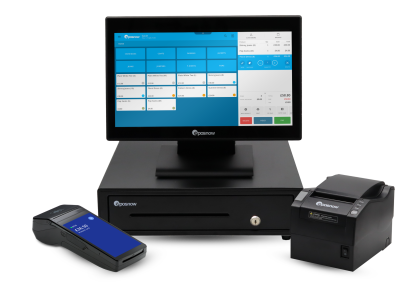What is EFTPOS?
The more you learn about the technology you need to run your business, the more surrounded you encounter long, confusing acronyms. It’s enough to make anyone want to go back to the old days of cash, coin, and simple over-the-counter sales.
But technologies like EFTPOS play a vital role in commerce, and every business needs to use them; once you understand them, you’ll find business much easier.
What does EFTPOS stand for?
Even as an acronym, EFTPOS is a bit of a mouthful. In its full form, EFTPOS means electronic funds transfer at point of sale.
The term can be confusing because while it always refers to the field or system of on-site electronic payments. People may use the term when speaking of either the payment card (an EFTPOS card), or the card machine (an EFTPOS machine). Ultimately, EFTPOS is the system of paying for products or services electronically when in a shop or a business.
The card payments industry uses a lot of different acronyms, and many of the terms vary from country to country. EFTPOS is used in Australia more than other locations, but people will use the term everywhere so knowing the meaning of the term is useful.
Epos Now provide the very best business tools with the flexibility to fit any business with what it needs to flourish:
- Create a full business suite on a solid EPOS foundation with integrated card payments, an online store, multi-site and multi-channel options
- Sell your own way with hardware and software options for every industry
- Save time with seamless card integrations on mobile and countertop EFTPOS devices
- Know your business better with hundreds of detailed, easy-to-read business reports

What is an EFTPOS machine?
If someone uses “EFTPOS machine” in a sentence, you’ll know they’re speaking about the card machines people use to pay and receive payments using bank cards. There are many different kinds of card machines on the market, but they’re all part of the system used to transfer money electronically.
EFTPOS devices usually connect to an EPOS which, combined, make an effective, streamlined method of serving customers. Many of the EPOS providers that make tills also make EFTPOS machines. Epos Now Payments is an excellent example of this, with a design tailored to work well with an Epos Now till system.
These devices first emerged in the 1980s but did not become fully mainstream until the 2000s, by which time most customer-facing businesses had one[1].
These days, cash-only businesses take heavy losses as a result of excluding cashless customers. Many consumers, particularly younger generations, do not carry wallets or purses where they can store change[2].
What does EFTPOS look like?
An EFTPOS can take two main forms. The more traditional hardware appears bulkier but can perform more complex tasks while functioning in “standalone mode” as well as connected to an EPOS device.
The traditional EFTPOS can take payments for a business by itself by contactless payment, a swipe of a card, or by card insertion. It can tally the totals of all payments and print z-read reports.
It can also perform refunds and serve customers even when they aren’t present or do not have the cards with them. The Epos Now Link adheres to this more traditional style.
In recent years, a second, simpler EFTPOS device has emerged. These devices don’t always work without an EPOS system connected to them, and settings changes often need to be made via the EPOS.
However, the smaller EFTPOS’ have become popular thanks to their practicality, portability, and slick, modern appearance which many businesses and consumers prefer to their bulkier counterparts.
How does EFTPOS work?
EFTPOS transactions follow a fairly standardised process with a series of steps being followed to complete each transfer of funds. Furthermore, each transfer incurs a series of expenses that the banks and the vendor must pay.
The card provider usually deducts these fees from the transaction itself. Consequently, many card machine deals involve a percentage of each transaction being transferred to the provider themselves.
 The process is different for various kinds of cards and accounts, so some card payments cost more than others (although Epos Now Payments blend these fees together so businesses always know how much they’re paying).
The process is different for various kinds of cards and accounts, so some card payments cost more than others (although Epos Now Payments blend these fees together so businesses always know how much they’re paying).
During payment processing, EFTPOS systems follow a series of steps:
- When a card is presented, the device encrypts and sends card and transaction data to the bank. This confirms that the account is authentic, the PIN is valid (if used) and funds are present and therefore the transaction is authorised to take place.
- The release of funds allows a transfer from the payment processor to the merchant account. This is an account where capital is stored on behalf of the business.
- At this point, the transaction is marked as complete and both business and customer can get on with their day.
- After the transaction, the customer’s bank will pay what is owed to the payment processor, and the money will be released to the business, transferring it from the merchant account to the business account[3].
Card machines use several different methods to calculate transaction pricing, some of which will work better for different kinds of businesses. As you can see above, this process is automatic, and managers only need to monitor transaction reports to stay on top of card payments.
This means a portion of every sale gets redirected out of the business. Nevertheless, EFTPOS works for businesses because the convenience and speed at which transactions can be completed help boost trade and reduce administrative fees.
Other terms used to describe EFTPOS
You’ll likely encounter terms like PDQ machine (process data quickly) and POS (point of sale) being used in similar ways. POS or EPOS (electronic point of sale) sometimes gets used when referring to card machines despite POS tills also being the software and hardware that holds business data and calculates sales (which connects or integrates with the card machine taking the funds).
Can EFTPOS be used online?
Ecommerce has given rise to many different modes of payment that different internet companies use to process transactions. However, EFTPOS is not one of them.
EFTPOS, you may recall, has “point of sale” within its name, which in this instance refers to a physical place where a transaction takes place. EFTPOS can take payments over the phone, can be mobile (which many businesses require), but cannot be virtual.
Find out how your business could benefit from an EPOS trusted by over 40,000 businesses worldwide.




